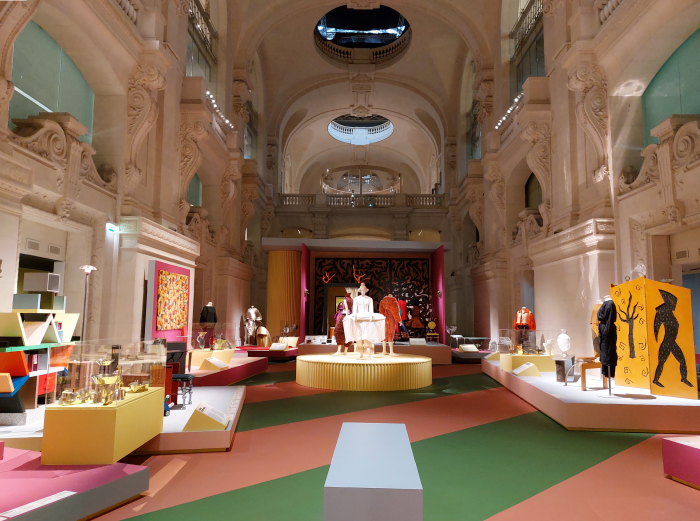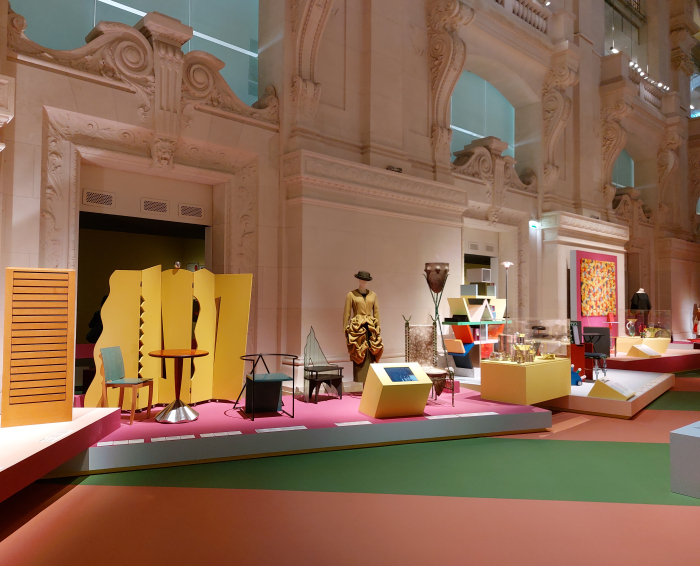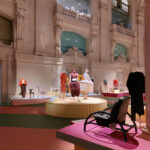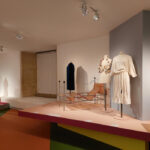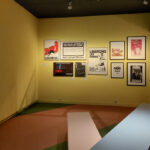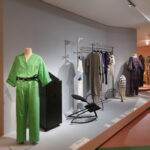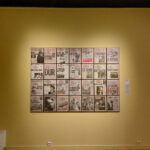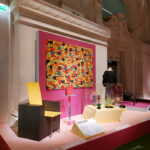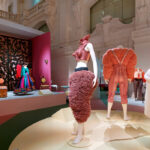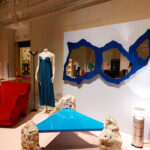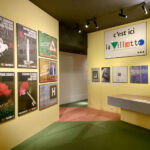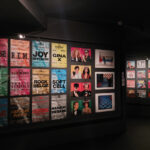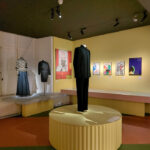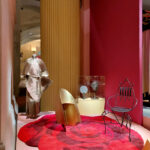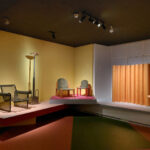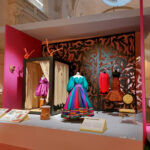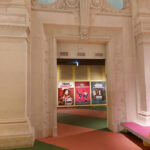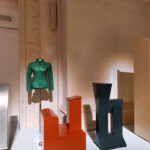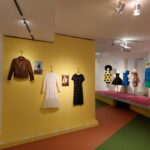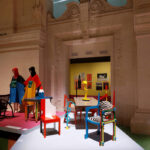Années 80. Mode, design et graphisme en France at the Musée des Arts décoratifs, Paris
In the 1880s design in France stood, in many regards, at the threshold of Art Nouveau, with the likes of, and amongst many others, Louis Majorelle, Émile Gallé or Hector Guimard beginning to start to question the production of, the formal expression of and our relationships with, our objects of daily use in context of the early years of the Third Republic and a rapidly rising industrialisation with all the associated social, economic, technical and political et al developments of the age.
And design in 1980s France?
With the exhibition Années 80. Mode, design et graphisme en France the Musée des Arts décoratifs, Paris, undertake a revue of creativity in that very recent, but somehow very distant, decade…….
One is greeted at the entrance to Années 80. Mode, design et graphisme en France by François Mitterrand. Not personally, given that he departed this world for the next in 1996 that would be weird, certainly awkward, if not grotesque; but rather by a campaign poster for the 1981 French presidential election which features a portrait of Mitterrand pitching himself as La force tranquille. Which is, in itself, more than a little disconcerting: tranquil, calm, peaceful not being adjectives that one normally associates with the 1980s, certainly not with creativity in the 1980s, nor necessarily being that which you had arrived at the Musée des Arts décoratifs expecting to be subjected to. La force brut, tumultueux, excessif, frivole, éclatant perhaps. But not tranquille. It’s the 1980s! You know… the 80s……!
Thus mulling the juxtaposition you pass-by François Mitterrand.
And past a poster, an election campaign, by Agence RSCG, under the creative direction of co-founder Jacques Séguéla, which, as the curators opine, “marks the beginning of marketing in politics”, the beginning of a move away from election posters carrying political messages to election posters selling politicians: so now we all know who to blame for where image over content politics has taken us. It was the French what did it. And a connection between contemporary creatives and civic society that is very much the theme of the opening chapters of Années 80; for all the manner in which French politicians, institutions and public bodies employed the talents of an up and coming generation of young French creatives. Promoted and advanced the positions of an up and coming generation of young French creatives, by way of promoting and advancing themselves.
A theme discussed, explored and elucidated in Années 80 primarily in context of the graphisme of the exhibition title, and via, and amongst a great many other projects: corporate identities for the Musée du Louvre, Musée d’Orsay or Centre national des arts plastiques developed by the collective Grapus; posters for a variety of organisations, campaigns and programmes by the likes of, and amongst many others, Speedy Graphito, Roman Cieslewicz or Michel Quarez; a series of 1981 Presidential election campaign posters for Mitterrand’s Parti socialiste by Claude Baillargeon developed parallel to the La force tranquille campaign but which rather than image focus on content, reminding us that in all spheres new ideas always arise alongside, and accompany, the existing, existing which continue to evolve and develop in the spirit of the age. And also by furniture, specifically furniture for the private apartment of the Élysée Palace, the official residence of the French President, including works by the likes of, and again amongst others, Annie Tribel, Marc Held or Philippe Starck.
And furniture which takes on a much greater role as one continues through Années 80.
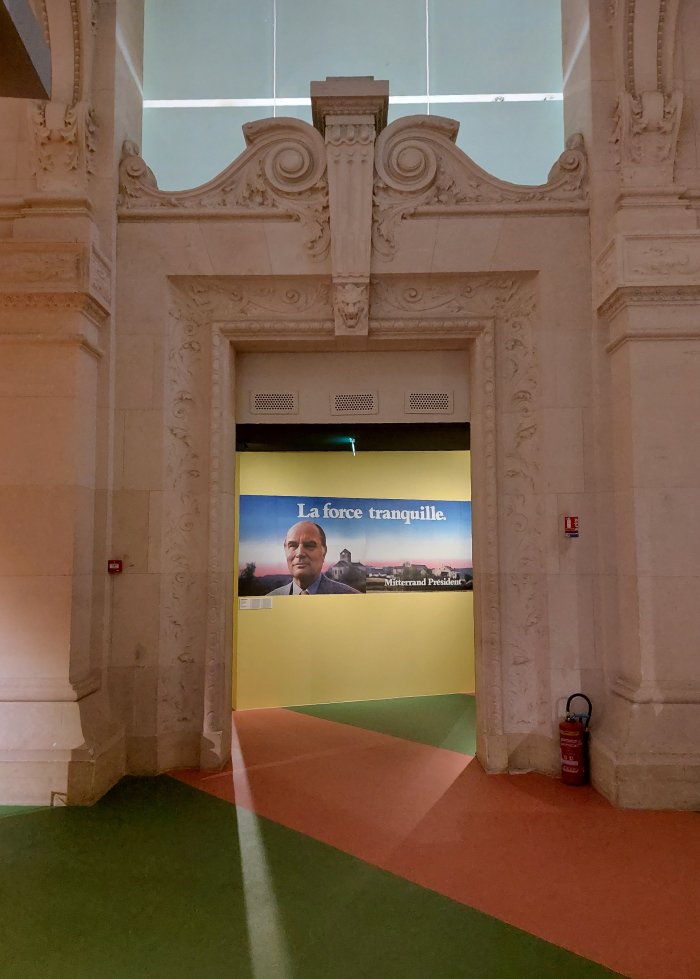
La force tranquille. And a ray of light, as seen at Années 80. Mode, design et graphisme en France, Musée des Arts décoratifs, Paris
In 1979 the, then, French government initiated the platform Valorisation de l’innovation dans l’ameublement, VIA, a body established with the aim of facilitating exchange between designers and the furniture industry, and who in addition, as part of that remit, ran, still run, a gallery in Paris that was, still is, an important space in context of providing exposure for young designers. And who also granted, grant, so-called Cartes Blanches, in essence stipends, to young designers to enable them to develop projects free of commercial pressures, free of that which a Rolf Fehlbaum once deliciously denounced as the “unmerciful censor of all ideas”1: the first Carte Blanche recipients including the likes of, for example, Martin Szekely, Jean-Michel Wilmotte or Philippe Starck. Later recipients including, and amongst many others, Inga Sempé, Matali Crasset, Pierre Charpin and Ronan Bouroullec.
A VIA which opens, and in many regards, leads into, provides access to, serves as path through… sorry… the chapter Effervescent Design, a chapter which alongside works by Carte Blanche recipients including François Bauchet, Pascal Mourgue or Jean-Charles de Castelbajac, the later represented by his 1986 Double Poncho for K-Way, a, well, double poncho, also features, in many regards introduces, Christian Lacroix and Jean Paul Gaultier, those two rapidly rising stars of 1980s French clothing design2; and a Jean Paul Gaultier who is also a VIA Carte Blanche alumnus, in context of which he developed a collection of, today, largely unknown furniture designs. But that was in Années 90, which one hopes is an exhibition currently in development.
And a chapter that is, and that very much to your surprise, populated by both French and non-French designers: for all that the French are famously highly protective of all things français, and particularly keen to avoid a creeping anglicisation of their culture, Effervescent Design features throughout its course a great many international creatives, including the likes of, for example, Shirō Kuramata, Ettore Sottsass or Tom Dixon. A mix of French and International designers found throughout Années 80; and a mix which reminds us all that, yes, France is actually part of global society, and, and much less flippantly, reminds that throughout (hi)story any and all perceived national creative narrative has been influenced and informed by international narratives, by the positions, approaches and expressions of an international creative community. Creativity, doesn’t, can’t, develop, in geographical and cultural isolation. And a process, an exchange, that although active for centuries, arguably, first became self-evident, matter-of-fact, even openly celebrated, in the 1980s.
Thus for all that Années 80 is unquestionably sited in France, it is very much an international revue.
An international revue sited in France. An international revue presented very much in a French context. Something underscored by the positioning of the international creatives firmly in context of French design galleries, including, for example, and amongst others, Galerie Nestor Perkal, Galerie En Attendant les Barbares or Galerie Néotù; galleries who are very pleasingly given a very prominent place in the Années 80 exhibition concept. A presence, and prominence, pleasing because on the one hand it helps delineate the 1980s as the start of a more authorial understanding of design, of a moment when, we’d argue, design picked up positions begun in the 1960s and started to become less for the industry it had been for and more an expression of the designer’s positions by way of contributing to contemporary discourses, started being less about objects to be produced en mass and more about the object as a mediator, that period when objects became design rather than being designed; and on the other hand is a prominence of galleries in Années 80 that is indicative of the prominent role galleries played in the dissemination of design at that period, a role, as with the state initiated VIA, which offered designers a space for creativity freed from conventional commercial pressures and demands; and a role that was very new in the 1980s. Was very important in the 1980s. And which continued to be important into the 1990s. And will continue to be so into 2030s.
A continuing relevance of années 80 into contemporary design that a quick, and easily recommendable, post-Années 80 excursion across the Seine, from the Rive Droite to the galleries of Rive Gauche, can readily, and entertainingly, confirm.3
Equally pleasing, and satisfying, is the manner in which the chapter Effervescent Design effortlessly, and very consciously, mixes clothing design with furniture, object and interior design; alongside the aforementioned Christian Lacroix and Jean Paul Gaultier, one also finds works by the likes of, for example, Issey Miyake, Popy Moreni, Claude Montana or Vivienne Westwood. A mixing of clothing with furniture, object and interior design that is found throughout Années 80, is very much one of the defining features of the exhibition concept and realisation; and a mixing that is pleasing and satisfying not least because clothing, furniture and accessories are those objects with which we all surround ourselves, are the arts décoratifs of the theatre of daily life, and which thus can’t be so readily separated, disjointed, from one another. Certainly shouldn’t be separated, disjointed, from one another in any revue of any given decade, being as they are inter-related and co-dependent components of the same discourses and developments and societies.
Is a mixing of clothing, furniture, lighting and object design found throughout Années 80 that was found throughout années 80.
A mix that also included music.
Music not in the exhibition title, but very much as present in Années 80 as it was in années 80.
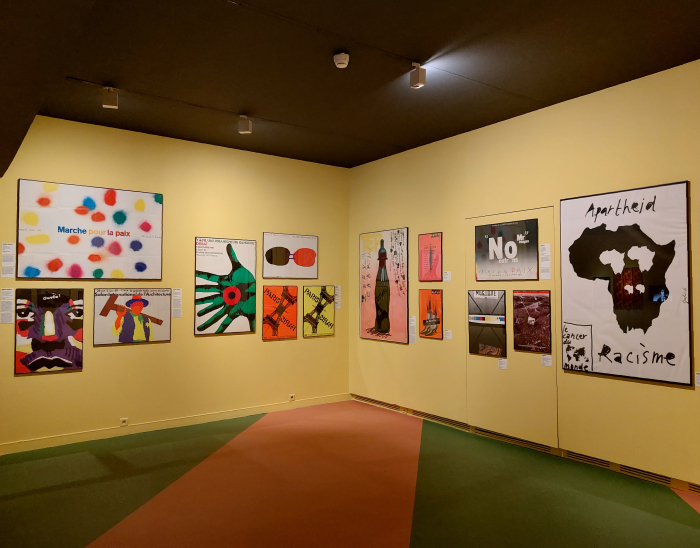
Political posters, as seen at Années 80. Mode, design et graphisme en France, Musée des Arts décoratifs, Paris
Années 80 music represented by, celebrated by, and amongst other exhibits, a selection of music videos featuring French artistes, the 1980s being, lest we forget, the decade of MTV and the rise of the music video, and also of the much missed Rapido, a television format that really wouldn’t have been possible before the 1980s, or anywhere else but France; a presentation of fanzines, those analogue networkers and promoters and advocates of alternative and underground music, of alternative and underground cultures, and which were not only important in giving many young bands a platform and visibility and validity, but were where so many important and interesting music journalists cut their teeth and crafted their art. And also a display of concert posters, primarily posters by the ever joyously monickered Loulou Picasso for concerts at Bains-Douches in Paris, an alternative venue that once stood just on the other side of Les Halles from the établissement of the Musée des Arts décoratifs, Louvre, and Jardin des Tuileries; and for concerts by the likes of, for example, R.E.M, Joy Division, Gina X or Funkapolitan, the latter of whom, as we all know, featured a young Tom Dixon on bass, before the consequences of a broken arm saw him move from music to design and become known for the furniture objects to be found elsewhere in Années 80.
The final chapters of Années 80 are reserved for the mode of the exhibition title, a state of affairs that leads you to the thought that, if the opening chapters were primarily graphisme and the closing chapters primarily mode, then the design of the title should actually be meubles, or perhaps intérieurs, for that is very much the focus of the middle chapters; closing clothing chapters where the first thing one notices, certainly the first thing we noticed, is/was that it’s not all shoulder-pads, rather, the 1980s offered a wide range of shoulder enshrouding formats including a great many libérée. And the second thing one notices is the evidence offered that on the one hand the 1980s saw large-scale referencing and re-imaging of times past, including of the inter-War decades, the 17th and 18th centuries and back, back, back to Antiquity, that latter of which reminding that classical forms played an important role in Postmodernism, that Postmodernism was in many regards a Neo-neoclassicism. And a referencing and a re-imaging that also makes note of the 1980s revival of Haute Couture, that popular image of, one could (cynically) argue that much hyped and vaunted marketing position of, the French clothing industry, certainly the Parisian clothing industry, and as explored in Années 80 through works by the likes of, for example, Hubert de Givenchy, Karl Lagerfeld, Yves Saint Laurent, Pierre Cardin or Erik Mortensen; thus a mix of protagonists closely involved in the first Haute Couture flush of the 1950s and 60s and also those new(er) protagonists who helped define the 1980s revival and its path into the 1990s and onward to today.
And on the other hand one notices how the 1980s saw new tendencies coming through, for example, alternative appreciations of our relationships with our clothing as represented in the works of a Rei Kawakubo; new positions to male clothing, an increasingly rapid move away from the suit and shirt of yore, and a liberation of what was considered suitable for contemporary males; or through new production and distribution systems that rejected, openly challenged, the established of the French clothing industry, as represented by, for example, Agnes B, NAF NAF or the mail order collections for Les 3 Suisses by designers as varied as Issey Miyake, Èlisabeth de Senneville, Popy Moreni. Or Philippe Starck, who created numerous furniture objects for Le 3 Suisses, including the Mister Bliss kneeling chair, a work from 1984 that could also be from tomorrow.
And just one of several furniture objects scattered through the clothing chapters, including works by the likes of Nemo, Marie-Christine Dorner, Andrée Putman or Eileen Grey. Not a new Eileen Grey work, Grey had passed away in 1976 aged 98, but the mirror Satellite originally created by Grey for her late-1920s villa E-1027 in Roquebrune-Cap-Martin on the French Riviera; and one of several Grey works re-issued in the 1980s following her posthumous rediscovery, rescuing from an unjust anonymity.
A (posthumous) rediscovery, a rescuing from an unjust contemporary, that is also very much at the core of Années 80.
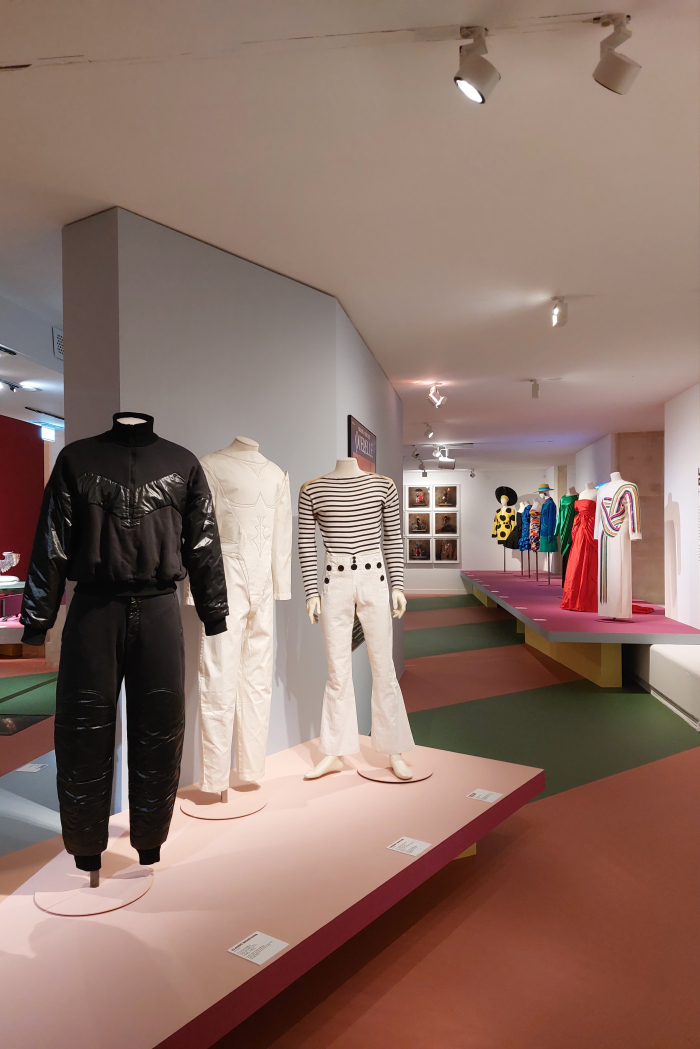
Men’s clothing by (l to r) Claude Montana, Thierry Mugler, Jean Paul Gaultier and female Haute Couture, as seen at Années 80. Mode, design et graphisme en France, Musée des Arts décoratifs, Paris
In context of the exhibition Anything Goes? Berlin Architecture in the 1980s at the Berlinische Galerie, Berlin, we opined that, in many regards, only now in the 2020s are we approaching a position where we have sufficient distance to begin to start to objectively assess, understand, engage with, the architecture of the 1980s, until now that simply hasn’t been possible, that until now it was very much a case of, 1980s architecture: ¯\_(ツ)_/¯. Now we are starting to be able to better read the 1980s. At the risk of sounding like a member of the Twitterati obsessed with having their opinions vindicated rather than integrated into a global discussion, obsessed with being proved right by way of massaging their fragile ego, Années 80 tends to imply the same about design.
Tends to lead one to an appreciation that that which today is popularly understood as design in the 1980s is only part of the story; tends to lead one to an appreciation that popular collective memories of design in the 1980s have become skewed, that popular memories of design in the 1980s have become condensed to a few easy tropes, have become an all too easy, lazy, pigeonholing into apparently well defined, unquestionable, static, categories, have been reduced to forms, colours and materials. To ¯\_(ツ)_/¯ . Années 80 contradicts that. Années 80 allows for fresh perspectives on the decade, allows for a resetting of understandings, a broadening of the discussion, and for more focussed considerations on not just the whats, but also the hows, whys and wherefores.
And in doing so allows one to develop appreciations that while the 1980s were without question driven by forces brut, tumultueux, excessif, frivole et éclatant there was also une force tranquille at work: for all the exuberance, decadence and insolence on show in Années 80, and there is a lot on show, there is also an awful lot of reduction, rationalisation and restraint. Often within the exuberant, decadent, insolent works, hidden by the exuberance, decadence and insolence. An awful lot of careful, controlled, considered, practice to be found, and enjoyed, in a great many of the works. An awful lot of informed approaches to developing established processes anew. An awful lot of highly skilled craft in unfamiliar contexts. An awful lot of evolution rather than revolution. Much as there is and was in the 1880s when one looks beyond the flowing, florid curves and licentiousness.
Or put another way, our contemporary popular focus on the forms, colours and materials of the 1980s, on the whats of the 1980s, while not wrong per se, does tend to mask the hows, whys and wherefores: those shifts in the understandings of and positions to design and design’s relationships to the individual and collective in the 1980s; those shifts in design’s understandings of its relationship to industry in the 1980s; those shifts in designers’ understandings of their role in the 1980s. And also those shifts in the definition of function in the 1980s, of function increasingly becoming not just the technical it had been raised to in the inter-War years, something form slavishly followed, but function also as the emotional, the tactile, the responsive, the implied, the derived, something that was acquainted with form, but very much did its own thing.
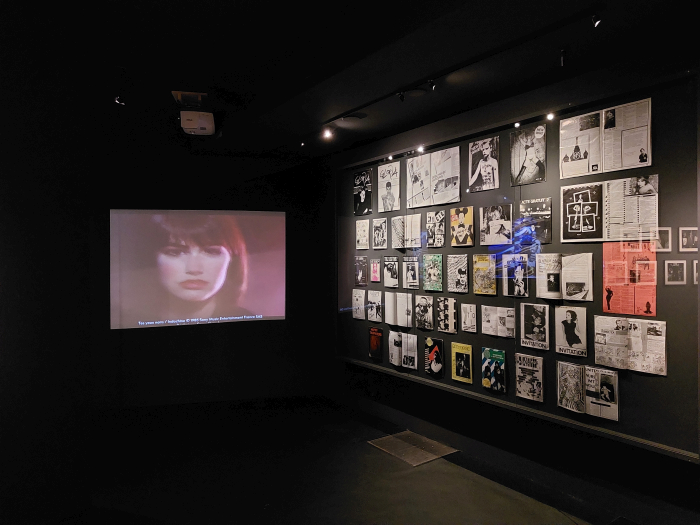
The video for Tes Yeux Noirs by Indochine (1985) and a selection of 1980s fanzines, as seen at Années 80. Mode, design et graphisme en France, Musée des Arts décoratifs, Paris
Shifts inextricably linked with, informed by, a response to, and in dialogue with the wider social, economic, technical and political et al realities of the period, not least the faltering industrialisation and the ever louder death throes of the post-War boom years as aftershocks of the oil crises and economic crises of the 1970s, and also the creeping global rise of Neoliberalism with its inherent focus on the individual over the collective, an economic survival of the fittest, or at least the best connected, a rise in many regards checked in France by a socialist President, but still very present in the global context in which 1980s France existed, not least in context of the rapidly approaching European Union. Thus much as 1880s France, 1880s Europe, stood at the threshold of a new unknown, so 1980s France, 1980s Europe. Unknowns creatives of all ilks launched themselves into. Much to the disdain and derision of established conventions and norms and practices.
Yet whereas in context of the 1880s we today are able to see that, are able to view developments with a distanced objectivity, and place the design developments of the age in context of the age, and in many cases be thankful that those developments occurred, not least when we consider them in context of our contemporary age, our contemporary objects of daily use; the 1980s have, we’d argue, until now, been too close to be properly, soberly, objectively viewed. Thus we have tended to primarily view 1980s design as objects. As colours. As materials. As forms. As frivole. As éclatant.
Until now. Now we are starting, but only starting, to achieve the necessary distance.
Something neatly underscored by Années 80: just a few short years ago Années 80 would have been an unbearable cacophony of forms, colours and materials, a shallow exercise in objectification, of writing hagiographies of Enfants Terribles, an attempt to define a “style”; today Années 80 is a questioning of how design of all genres should, could, must, move forward from the 1980s into a coming unknown, is an elucidation of the positions and approaches and motivations of the period, a recounting of discourses and arguments, and thus Années 80 is a very welcome, and timeous, invitation to begin moving towards more probable understandings of design in the 1980s in context of the 1980s, is un espace tranquille to engage with design in the 1980s free off preconceptions and prejudices. Yes, an invitation, un espace, sited very much in 1980s France, but the exhibtion concept makes extrapolation to European contexts relatively straight forward.4
And in doing so, in allowing for new, more nuanced, appreciations of the values and geneses and intentions and raisons d’être and shortcomings and dead ends of design from the 1980s, in allowing you to begin to learn to read design in the 1980s for yourself rather than relying on a few yellowing synopses, also allows you to better appreciate the paths taken since the 1980s and of the ongoing relevance and legacy of the 1980s in contemporary design. And thus for differentiated reflections on where we are in our own age, with our own social, economic, technical and political et al realities, and the thereby associated urgent need for a popular questioning of the production of, the formal expression of and of relationships with, our objects of daily use. As we launch ourselves into a coming unknown.
Into a future that was only rarely, if ever, as unknown and as uncertain.
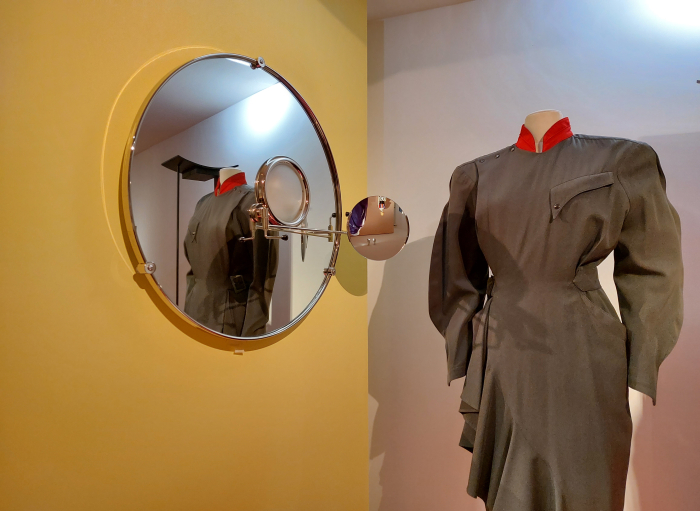
The mirror Satellite by Eileen Grey and a dress by Thierry Mugler, as seen at Années 80. Mode, design et graphisme en France, Musée des Arts décoratifs, Paris
Hosted in a building that, in many regards, owes its existence as a museum to developments in 1780s France, its continuing existence as a museum to events of 1880s France and which underwent a major refurbishment in 1980s France, Années 80 is presented in an exhibition design by Adrien Rovero, a Swiss designer born in 1981, a decision we originally found odd, but which having viewed Années 80 consider much preferable to commissioning a French designer active in 1981. And that not least because whereas someone who was part of design in 1980s France would, in all probability, produce a setting based on their experiences and positions of the period, and thus something far removed from popular perceptions, the distance a Rovero brings allows for the creation of a, as Alexander Girard described his La Fonda del Sol restaurant interior, “a special ‘stage world’ and not a historically or realistically accurate reproduction of any given place or proto-type”.5 Rovero incorporating all that which you expect to find in a 1980s design exhibition, including a suitably garish colour scheme and a preponderance of abstract forms; which, yes, is a little obvious, but, be honest, you’d be disappointed otherwise. We certainly would have been most disappointed. And a “stage world” which in its easy familiarity allows you to concentrate on the presentation.
A presentation featuring some 700 objects from across creative genres, approaches and positions, by a roster of creatives both popularly well known and much less so, yet all of relevance to the (hi)story being told, and ably supported and expanded by numerous bilingual French/English texts, notes and explanations; a presentation which in its breadth can provide for no more than a fleeting overview of creativity as expressed and experienced in the France in the 1980s.
Which isn’t a criticism, far from it: not least because rediscovering, rescuing, design from the 1980s requires an initial stock-take. And while presenting a stock-take invariably filtered through the curators, in its breadth Années 80 allows one to better appreciate both the connections and correlations and also the contradistinctions and contradictions, helps make clear that creativity in 1980s France wasn’t the readily definable homogeny you may have believed it to have been, but was very much a heterogenous moment, if one with many recurring themes, motifs, positions and formal expressions: wandering through the various chapters you quickly appreciate that Années 80 can’t make definitive statements on design in 1980s France. For there is no definitive.
But what it can do, and what is does very pleasingly, accessibly and uncomplicatedly, is introduce design in 1980s France to those of us who weren’t there, re-introduce it to those of us who were, and in doing so not only helps design in France in the 1980s become once more that what it was, but tells the tale of a 1980s design that was unmistakably part of a European whole, albeit with its own dialects, expressions and spirits. And then leaves you to follow up on your own, to dive deeper into, those aspects, those genres, those creatives, that most attract your attention.
And your attention will be attracted.
Just not necessarily by that which you thought it would be.
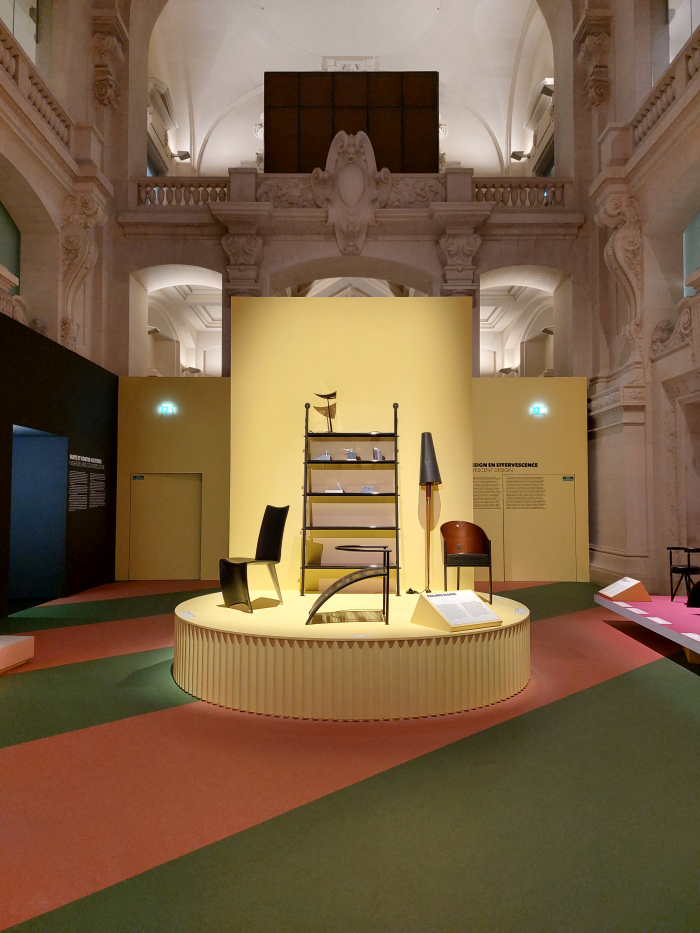
Philippe Starck, as seen at Années 80. Mode, design et graphisme en France, Musée des Arts décoratifs, Paris
While beyond the wider reflections on the 1980s initiated by the presentation, you are also very much encouraged to get up close and personal with the exhibited works; and alongside a great many well known objects there are also, and most satisfyingly, an awful lot of only very rarely seen charming, communicative, cultured, and frivole, éclatant, objects to engage with.
For our part we thoroughly enjoyed exchanges with, and amongst a great many more, Marc Held’s 1983 dining chair for the Élysée Palace whose base is pining for the 1930s while the seat shell is longing, achingly so, for the 1990s; the chair Square by Bordeaux based collective Épinard Bleu which can be used in four different positions, as four different chairs, represents a cubic rather than a cubist approach to sitting and a work that plays outrageously with, takes joyous liberties with, the square, circle and triangle of Bauhaus; Nathalie du Pasquier’s chair Pilar which on the one hand elucidates du Pasquier was more than the prints and photos she’s popularly known for, and also reminds that for all Memphis is held up as a moment of Anni ’80 in Italy, it was an international collective; Nemo’s chair pair Moreno Marini, the one curving forward, the other backward like two dancers in an exchange, and which underscores that furniture isn’t passive in a space, always exists in relationships; Jean-Michel Wilmotte’s stool Élysée for the Mitterands’ bedroom and which does absolutely nothing you’d expect a 1980s stool to do, and does only very little you’d expect a 2020s stool to do, and thus allows for reflections on the much over used, and poorly defined, phrase “timeless”. Or François Bauchet’s Meuble À P.F. and Meuble À D.L. two, we’re saying, workstations, desks-cum-chairs, that each allow for a variety of sitting, perching, working, positions; the one named after the artist Denis Laget the other after the artist Philippe Favier, and which thus may reference their preferred working positions; works which very much find an echo in Tripus by Florian Knöbl & Jannik Lang as seen at the Hochschule für Gestaltung Karlsruhe’s 2018 Rundgang. And two eminently engaging and highly communicative works absolutely crying out for a reissue, demanding to be in every home office. In France and beyond.
And a wide range of works from across genres, whereby, yes, we did just focus on furniture in that last paragraph, for which we don’t apologies, it’s how we tick, how we view and understand the world… a wide range of works from across genres that tends to an appreciation that while clothing design in and from France is often held up as the standard others have to achieve, that isn’t necessarily so for all genres of design. Why not?
Or put another way, and staying with our furniture-centric view, is a wide range of furniture works that tends to echo the appreciation acquired from viewing Mimesis. A Living Design at the Centre Pompidou-Metz that furniture design from France is a lot more that it is popularly understood to be, that furniture design from France is far too regularly, and most, most, unfairly, popularly overlooked in favour of furniture design from elsewhere. Années 80 is a further, strong, admonishment that we should all stop doing that, and should start engaging more with furniture design in and from France.
But for all Années 80 is an admonishment to engage more seriously with design of all genres of the 1980s, regardless of geographic origins, that the time has come to stop pigeonholing and stereotyping design of the 1980s, and in doing so to both enable design of all genres of the 1980s to become as familiar and commonplace as that of the 1880s, and also to allow us all to move as close to the mode, design et graphisme of années 1980 as we are to the mode, design et graphisme of années 1880…….
Années 80. Mode, design et graphisme en France is scheduled to run at the Musée des Arts décoratifs, 107-111, rue de Rivoli, 75001 Paris until Sunday April 16th.
Full information, including information on opening times, ticket prices, current hygiene rules, and details of the accompanying fringe programme can be found at https://madparis.fr/
In the interests of completion the soundtrack to the writing of this post was a variety of French “Best of the 80s” compilations as found on our preferred streaming service. Should you feel inspired to listen to such, please do, but please be aware, be warned, it’s not all Joe le taxi…..
- Années 80. Mode, design et graphisme en France, Musée des Arts décoratifs, Paris
- Works by, amongst others, Rei Kawakubo, Martin Margiela and Nemo, as seen at Années 80. Mode, design et graphisme en France, Musée des Arts décoratifs, Paris
- Radio posters, as seen at Années 80. Mode, design et graphisme en France, Musée des Arts décoratifs, Paris
- Works for Naf Nafand Les 3 Suisses, as seen at Années 80. Mode, design et graphisme en France, Musée des Arts décoratifs, Paris
- Examples of the new editorial design of the newspaper Libération, as seen at Années 80. Mode, design et graphisme en France, Musée des Arts décoratifs, Paris
- Works by, amongst others, Shiro Kuramata, Ettore Sottsass and Issey Miyake Galerie Gastou, as seen at Années 80. Mode, design et graphisme en France, Musée des Arts décoratifs, Paris
- Jean Paul Gaultier, as seen at Années 80. Mode, design et graphisme en France, Musée des Arts décoratifs, Paris
- Works by, amongst othes Elizabeth Garouste et Mattia Bonetti for Galerie Néotù, as seen at Années 80. Mode, design et graphisme en France, Musée des Arts décoratifs, Paris
- Posters by Claude Baillargeon for Parti socialiste and a corporate identity for La Villette by Grapus, as seen at Années 80. Mode, design et graphisme en France, Musée des Arts décoratifs, Paris
- Concert posters by Loulou Picasso for Bains-Douches, as seen at Années 80. Mode, design et graphisme en France, Musée des Arts décoratifs, Paris
- Clothing design by (l to r) Martin Margiela, Azzedine Alaïa and Thierry Mugler, as seen at Années 80. Mode, design et graphisme en France, Musée des Arts décoratifs, Paris
- Works by, amongst others, Popy Moreni, Jean-Philippe Gleizes and Éric Schmitt through Galerie En Attendant les Barbares, as seen at Années 80. Mode, design et graphisme en France, Musée des Arts décoratifs, Paris
- Works by (l to r) Ronald Cecil Sportes, Annie Tribel & Marc Held for the Élysée Palace, as seen at Années 80. Mode, design et graphisme en France, Musée des Arts décoratifs, Paris
- Works by Christian Lacroix and Elizabeth Garouste et Mattia Bonetti, as seen at Années 80. Mode, design et graphisme en France, Musée des Arts décoratifs, Paris
- Advertising posters, as seen at Années 80. Mode, design et graphisme en France, Musée des Arts décoratifs, Paris
- Meuble À P.F. and Meuble À D.L. by François Bauchet and a leather jacket by Claude Montana, as seen at Années 80. Mode, design et graphisme en France, Musée des Arts décoratifs, Paris
- Works by Agnes B (l) and Haute Couture pieces (r), as seen at Années 80. Mode, design et graphisme en France, Musée des Arts décoratifs, Paris
- Années 80. Mode, design et graphisme en France, Musée des Arts décoratifs, Paris
1. Rolf Fehlbaum, Ein Projekt mit ungewissen Ausgang, in Uta Brandes; Alexander von Vegesack [Ed], Citizen Office: Ideen und Notizen zu einer neuen Bürowelt, Steidl Verlag, Göttingen, 1994
2. Just to clarify….fashion and design stand contrary to one another, thus the popularly used phrase “fashion design” is an oxymoron, it is either fashion or design. The more correct term, certainly round our way, is clothing design, as in furniture design, lighting design, interior design, stage design, toy design, etc, etc, etc.
3. There are also design galleries in the arrondissements on the Right Bank. We however only had time to hop across the Seine, but had plans to visit galleries across Paris. A plan that was never going to work……..
4. We are very deliberately talking about France and Europe, for while there were invariably developments globally it would be generalising too far, even for us, to claim what happened in France was happening everywhere. Within Europe we are however on pretty safe ground.
5. Unreferenced quote in Todd Oldham & Keira Coffee, Alexander Girard, AMMO 2011
Tagged with: 1980s, Adrien Rovero, Années 80, Années 80. Mode design et graphisme en France, France, Jean Paul Gaultier, Mode, Mode design et graphisme en France, Musée des Arts Décoratifs, Paris, Philippe Starck, Postmodernism
